
Artillery are ranged weapons that launch munitions far beyond the range and power of infantry firearms. Early artillery development focused on the ability to breach defensive walls and fortifications during sieges, and led to heavy, fairly immobile siege engines. As technology improved, lighter, more mobile field artillery cannons developed for battlefield use. This development continues today; modern self-propelled artillery vehicles are highly mobile weapons of great versatility generally providing the largest share of an army's total firepower.

A shell, in a military context, is a projectile whose payload contains an explosive, incendiary, or other chemical filling. Originally it was called a bombshell, but "shell" has come to be unambiguous in a military context. A shell can hold a tracer.
This article explains terms used for the British Armed Forces' ordnance (weapons) and ammunition. The terms may have different meanings depending on its usage in another country's military.

Minenwerfer is the German name for a class of short range mine shell launching mortars used extensively during the First World War by the Imperial German Army. The weapons were intended to be used by engineers to clear obstacles, including bunkers and barbed wire, that longer range artillery would not be able to target accurately.

The Newton 6-inch mortar was the standard British medium mortar in World War I from early 1917 onwards.
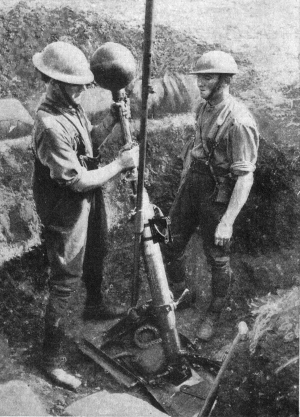
The 2 inch medium trench mortar, also known as the 2-inch howitzer, and nicknamed the "toffee apple" or "plum pudding" mortar, was a British smooth bore muzzle loading (SBML) medium trench mortar in use in World War I from mid-1915 to mid-1917. The designation "2-inch" refers to the mortar barrel, into which only the 22 in (560 mm) bomb shaft but not the bomb itself was inserted; the spherical bomb itself was actually 9 in (230 mm) in diameter and weighed 42 lb (19 kg), hence this weapon is more comparable to a standard mortar of approximately 5–6 in (130–150 mm) bore.
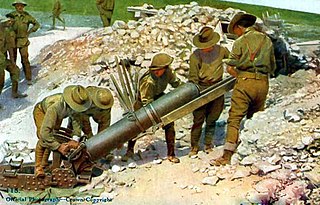
The ML 9.45 inch heavy trench mortar, nicknamed the "Flying Pig", was a large calibre mortar of World War I and the standard British heavy mortar from the autumn of 1916. It was a modification of an original French design, the Mortier de 240 mm developed by Batignolles Company of Paris and introduced in 1915. Britain manufactured the modified version under licence.

The 240 mm trench mortar, or Mortier de 240 mm, was a large calibre mortar of World War I. An original French design, it was developed by Batignolles Company of Paris and introduced in 1915.
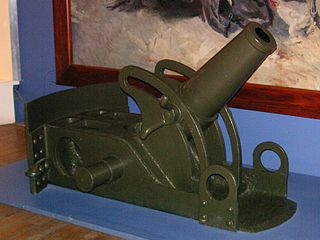
The Mortier de 58 mm type 2 or Mortier de 58 mm T N°2, also known as the Crapouillot or "little toad" from its appearance, was the standard French medium trench mortar of World War I.

The M549 is a high-explosive rocket-assisted (HERA) 155 mm howitzer round developed for use by the US military in order to add additional range to standard howitzers, with a maximum range 30.1 km (18.7 mi) from a M198 howitzer. The projectile has two distinctive pre-assembled components—the high explosive (HE) warhead and the rocket motor, making it a form of rocket-assisted projectile. The warhead is fabricated from high fragmentation steel for increased effectiveness in terms of damage caused to target and contains a bulk-filled explosive.
The Type 3 81 mm mortar is a smooth bore, muzzle-loading 81 mm (3.19 in) infantry weapon used by the Imperial Japanese Army during World War II. The Type 3 designation was given to this gun as it was accepted in the 3rd year of Emperor Taishō's reign (1914).

Albrecht mortars or Albrecht Schwerer Minenwerfers were a series of wooden heavy mortars used by the Imperial German Army during the First World War.

The 21 cm Mörser 99 was a German siege mortar built by Krupp which served during World War I. The mortar utilized a new nickel-steel alloy of greater strength than other cast cannons, though it lacked a recoil mechanism. While the gun was more effective than previous models, it was soon phased out because of improved field artillery and counter-battery fire, though it remained in service in limited numbers throughout the war because of heavy German losses.

The Mortier de 75 modèle 1915 Schneider was a French trench mortar designed and built by Schneider that saw action with the French and Belgian Army during the First World War.

The 24 cm schwere Flügelminenwerfer IKO or 24 cm sFIMW IKO was a heavy mortar used by the Imperial German Army during the First World War.
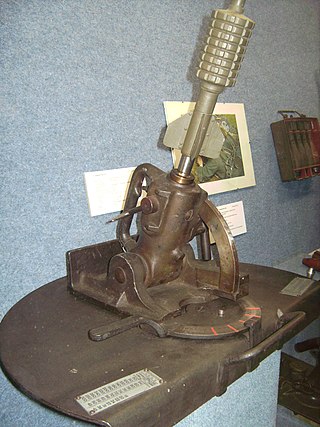
The kleineGranatenwerfer 16 or Gr.W.16(Small Grenade Launcher Model 1916) in English, was an infantry mortar used by the Central Powers during the First World War. It was designed by a Hungarian priest named Father Vécer and was first used by the Austro-Hungarian Army in 1915. In Austro-Hungarian service, they received the nickname "Priesterwerfers". In 1916 Germany began producing a modified version under license for the Imperial German Army.

The Mortier de 58 T N°1 sometimes referred to as Lance Torpilles was an early French medium trench mortar of World War I. Built in small numbers it was a transitional type in the development of later French mortars.
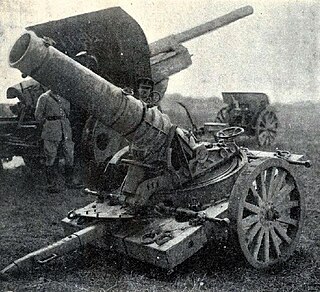
The 24 cm schwere FlügelMinenWerfer Albrecht, or 24 cm sFIMW 17 Albrecht, was a heavy mortar used by the Imperial German Army during the First World War.

The Mortier de tranchee de circonstance Cellerier or Cellerier Mortar was an early French light infantry mortar of World War I. The name roughly translates to (Cellerier Improvised Trench Mortar) in English.

The Mortier de 58 T N°1 bis sometimes referred to as Lance Torpilles was an early French medium trench mortar. It was used by both the French Army and Italian Army during the First World War.



















